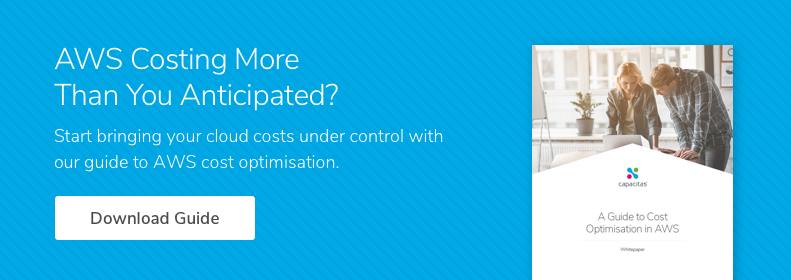While the global move to cloud-based infrastructure has delivered undoubted benefits in security, storage and scalability, it’s also brought with it the risk of spiralling costs as companies struggle to adequately track their cloud use and manage their spending.
Given that the primary reason many businesses switch to the cloud in the first place is to save costs, this is a huge potential problem. So, what’s most important in keeping your cloud costs down and only paying for what your business actually needs?
What Causes Cloud Cost-inefficiencies?
We’ve worked with many businesses—from blue chips to SMEs—to reduce or control their AWS cloud costs and, regardless of size, we’ve seen the same 5 challenges recur again and again.
1. Over-sizing
This is the most common reason for cloud overspending and is usually the result of inherent design problems such as:
- Capacity added that isn’t needed
- Inaccurate sizing due to poor performance testing
- Excess capacity added to deal with software bottlenecks
- Incorrect demand forecasts
2. Software Inefficiency
Another often-overlooked area of potential cost is software efficiency, defined as the ‘amount of computing resource required per business transaction’ in our 7 Pillars of Software Performance. For obvious reasons, this is a huge factor in controlling your cloud costs — particularly if you’re processing a high volume of transactions. It often stems from:
- Failing to measure efficiency
- Not knowing what efficiency looks like
- Not having Non-Functional Requirements or targets
3. Sub-optimal Architecture
This is usually the result of businesses rushing their architecture choices due to the clamour to move to the cloud as soon as possible. While this might get the C-suite off your back in the short term, it often causes problems further down the line when your architecture doesn’t fit your workload. This can lead to either purchasing capacity you don’t need or paying more for extra when what you’ve bought can’t keep up.
4. Inelasticity
Using autoscaling can be a great way to manage cost by adjusting capacity to counter changing demand. However, many applications don’t autoscale quickly enough — particularly databases, caches and dated applications. The result is that you still overextend your capacity and spend money where it isn’t needed.
5. Forecasting Complexity
Forecasting what you’ll need and when you’ll need it is difficult. It requires a robust process, specialist analysis skills, and the right data. To give an accurate forecast, you’ll need to be cognisant of:
- The introduction of new services and how much capacity they’re likely to need
- Changes in business demand for existing services
- Changes in efficiency of existing services - driven by software releases
All of which makes managing your cloud costs a complex proposition, so how should you approach it?
What’s the Best Approach to Cloud Cost Management?
Cloud cost management can broadly be divided into two approaches: ‘quick fixes’ that tackle low-hanging fruit such as wasted capacity and ‘long-term fixes’ that deal with more ingrained issues.
Quick Fixes
There are a number of palliative fixes to cloud overspend that
- Shutting down cloud capacity that’s not in use
- Leveraging discount options with your provider
- Using more cost-effective regions for server storage
- Running dev instances only when needed
- Using reserved instances
- Implementing budget controls
There are plenty of powerful tools available to help you automate and track these processes, such as Amazon Cloudwatch, Trusted Advisor, Cloudability,
Most companies with a significant volume of business transactions we come across use one of these tools, but we often find they struggle to harness its full potential. It can be hard to translate the tool’s recommendations into real-world fixes, so many businesses only ever implement a fraction of the optimisations they could.
What’s more, many of these fixes are limited in scope and won’t fix the deeper, more sustained issues that drive cloud overspending. For example, none of the listed tools is suitable for assessing the long-term efficiency or scalability of your cloud architecture. Likewise,
For these more complex and potentially more high-risk tasks, you need something beyond a cost-optimisation tool.
Long-term Fixes
Addressing problems with strategic aspects of cloud cost optimisation, such as forecasting and scalability, requires comprehensive analysis. Building upon the ‘quick fixes’ outlined in the previous section, in-depth analysis should ask questions about the long-term scalability of your cloud architecture, whether your spending can be benchmarked against the market and similar workloads and how much your choice of technology is likely to cost you in 1, 2 or 5 years’ time.
Delving a little deeper into your cloud cost
This is where
To learn more about our approach, as well as where to start with your own cloud cost management, download our new control cloud costs whitepaper.

